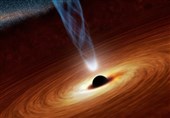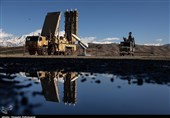Black Hole Size of Our Solar System Unveils Movie of Observable Universe
TEHRAN (Tasnim) – In April 2019 the astronomers at Harvard’s Black Hole Initiative were asking what does the glowing bright orange ring around the now iconic black hole the size of our solar system at the center of the monster elliptical galaxy M87 – the largest, most massive galaxy near us mean?
This is according to Harvard Event Horizon telescope radio astronomer, Michael Johnson.
A Lens the Size of Earth
The image marked the endpoint of years of work undertaken by a team of 200 scientists across 18 countries that drew on data collected by eight telescopes whose locations range from Hawaii to the South Pole, creating the equivalent of a lens the size of planet Earth that’s 4,000 times more powerful than the Hubble Space Telescope that captured light from the entire universe wrapping around the object in a nested series of rings. “As we peer into these rings,” said Peter Galison of Harvard, an EHT collaborator, “we are looking at light from all over the visible universe, we are seeing farther and farther into the past, a movie, so to speak, of the history of the visible universe” as witnessed by a black hole, playing on a dramatically curved screen tens of billions of kilometers across.
The EHT team, reports the National Science Foundation, has used the lessons learned last year to analyze the archival data revealing the behavior of the black hole image across from 2009-2013, indicating persistence of the crescent-like shadow feature that appears to be wobbling.
“With the incredible angular resolution of the EHT we could observe a billiard game being played on the Moon and not lose track of the score!” said Maciek Wielgus, an astronomer at Center for Astrophysics | Harvard & Smithsonian, Black Hole Initiative Fellow, and lead author of the paper, referring to the technique of Very Long Baseline Interferometry (VLBI) to provide a uniquely high image resolution.. In 2009-2013 M87* was observed by early-EHT prototype arrays, with telescopes located at three geographical sites in 2009-2012, and four sites in 2013. In 2017 the EHT reached maturity with telescopes located at five distinct geographical sites across the globe.
What’s Cloaked in the Data?
“Last year we saw an image of the shadow of a black hole, consisting of a bright crescent formed by hot plasma swirling around M87*, and a dark central part, where we expect the event horizon of the black hole to be,” said Wielgus. “But those results were based only on observations performed throughout a one-week window in April 2017, which is far too short to see a lot of changes. Based on last year’s results we asked the following questions: is this crescent-like morphology consistent with the archival data? Would the archival data indicate a similar size and orientation of the crescent?”
The 2009-2013 observations consist of far less data than the ones performed in 2017, making it impossible to create an image. Instead, the EHT team used statistical modeling to look at changes in the appearance of M87* over time. While no assumptions about the source morphology are made in the imaging approach, in the modeling approach the data are compared to a family of geometric templates, in this case rings of non-uniform brightness. A statistical framework is then employed to determine if the data are consistent with such models and to find the best-fitting model parameters.
Expanding the analysis to the 2009-2017 observations, scientists have shown that M87* adheres to theoretical expectations. The black hole’s shadow diameter has remained consistent with the prediction of Einstein’s theory of general relativity for a black hole of 6.5 billion solar masses. “In this study, we show that the general morphology, or presence of an asymmetric ring, most likely persists on timescales of several years,” said Kazu Akiyama, a Jansky Fellow of the National Radio Astronomy Observatory (NRAO) at MIT Haystack Observatory, and a contributor to the project. “The consistency throughout multiple observational epochs gives us more confidence than ever about the nature of M87* and the origin of the shadow.”
“A Hidden Surprise”
But while the crescent diameter remained consistent, the EHT team found that the data were hiding a surprise: the ring wobbles, and that means big news for scientists. For the first time, they can get a glimpse of the dynamical structure of the accretion flow so close to the black hole’s event horizon, in extreme gravity conditions. Studying this region holds the key to understanding phenomena such as relativistic jet launching, and will allow scientists to formulate new tests of the theory of General Relativity.
The gas falling onto a black hole heats up to billions of degrees, ionizes and becomes turbulent in the presence of magnetic fields. “Because the flow of matter is turbulent, the crescent appears to wobble with time,” said Wielgus. “Actually, we see quite a lot of variation there, and not all theoretical models of accretion allow for so much wobbling. What it means is that we can start ruling out some of the models based on the observed source dynamics.”
“The Future” –Real-Time Movies of Black Holes
“These early-EHT experiments provide us with a treasure trove of long-term observations that the current EHT, even with its remarkable imaging capability, cannot match,” said Shep Doeleman, Founding Director, EHT. “When we first measured the size of M87* in 2009, we couldn’t have foreseen that it would give us the first glimpse of black hole dynamics. If you want to see a black hole evolve over a decade, there is no substitute for having a decade of data.”
“What I predict is that by the end of the next decade we will be making high quality real-time movies of black holes that reveal not just how they look, but how they act on the cosmic stage,” Doeleman, told AFP in an interview.
“Monitoring M87* with an expanded EHT array,” says EHT Project Scientist Geoffrey Bower, Research Scientist of the Academia Sinica, Institute of Astronomy and Astrophysics (ASIAA), “will provide new images and much richer data sets to study the turbulent dynamics. We are already working on analyzing the data from 2018 observations, obtained with an additional telescope located in Greenland. In 2021 we are planning observations with two more sites, providing extraordinary imaging quality. This is a really exciting time to study black holes!”






